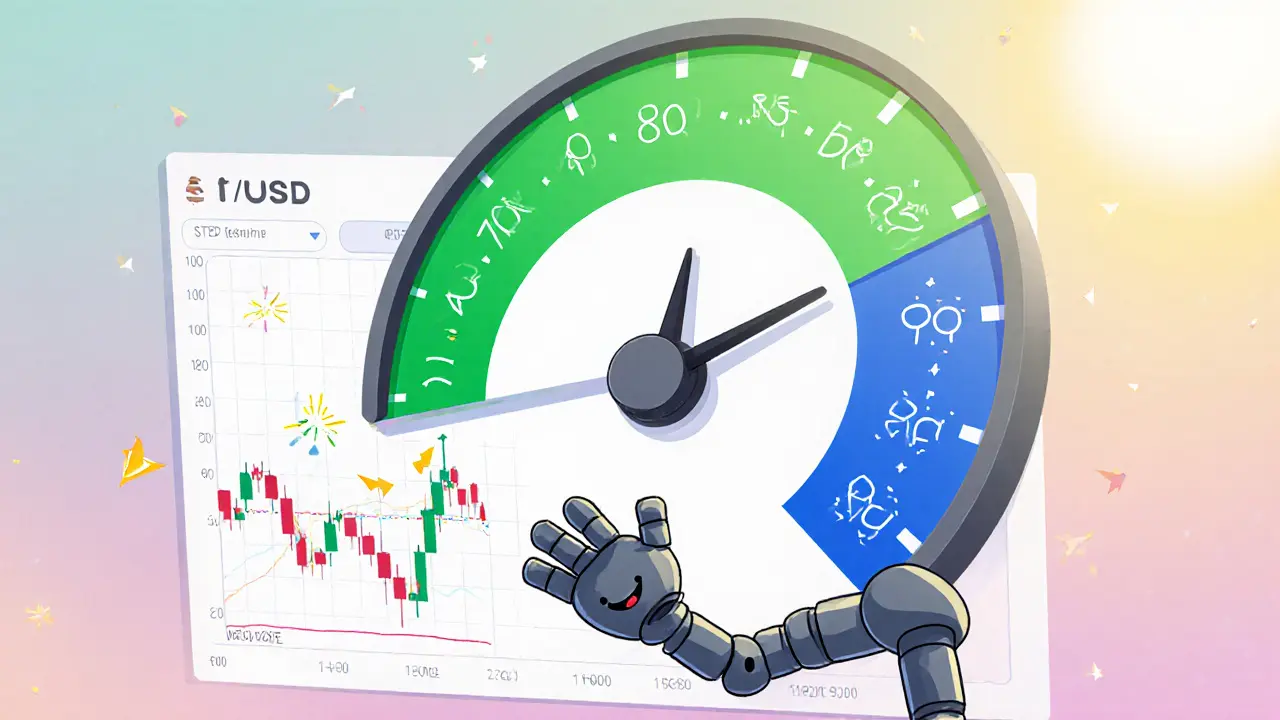RSI & MACD Signal Calculator
Price Data Input
Trading Signals
Ever stared at a crypto chart and wondered why the price spikes keep confusing you? Two of the most common tools that traders reach for are the RSI (Relative Strength Index) and the MACD (Moving Average Convergence Divergence). Both were created decades ago, but they still dominate dashboards on TradingView, Binance, and even traditional stock platforms. This guide breaks down what each indicator does, how they differ, and how you can apply them to Bitcoin, Ethereum, or any alt‑coin without getting lost in jargon.
RSIWhat the Relative Strength Index actually measures
The RSI is a momentum oscillator that swings between 0 and 100. Developed by J. Welles Wilder Jr. in 1978, it compares the average size of recent gains to the average size of recent losses over a chosen period - most traders stick with the default 14‑day setting.
When the line climbs above 70, the market is considered “overbought” - meaning buyers may have pushed the price too high, and a pull‑back could be coming. Below 30, the market is “oversold,” suggesting a possible bounce. The 50‑level serves as a neutral mid‑point: values above 50 hint at bullish momentum, below 50 point to bearish pressure.
Because the RSI is plotted in a separate pane beneath the price chart, you can instantly spot divergences - situations where price makes a new high, but the RSI fails to do so (or vice‑versa). Divergence often precedes a reversal, which is why many crypto traders value the indicator for spotting early entry points.
How to calculate RSI in practice
- Choose a look‑back period (14 is standard for daily charts).
- Sum all positive price changes over the period, then divide by the number of periods - this gives the average gain.
- Do the same for negative price changes to get the average loss.
- Divide average gain by average loss to obtain the relative strength (RS).
- Plug RS into the formula:
RSI = 100 - (100 / (1 + RS)).
Most platforms do the math for you, but knowing the steps helps you tweak the period for volatile assets like Bitcoin, where a 7‑period RSI can react faster to rapid price swings.
Strengths and pitfalls in the crypto world
RSI shines in ranging markets - think of a sideways‑moving alt‑coin that bounces between support and resistance. Here, the 30/70 thresholds reliably flag exhaustion points. However, during strong bull runs (like the 2020‑2021 crypto rally), the RSI can remain overbought for weeks, generating false sell signals. A common fix is to raise the overbought line to 80 or wait for the line to close above 70 before acting.
Another trick is using an adaptive version. TradingView introduced an Adaptive RSI in early 2023 that expands or contracts the thresholds based on recent volatility, reducing whipsaws in choppy markets.
Practical crypto example
Imagine ETH/USD on a 4‑hour chart. The price climbs from $1,800 to $2,200 in three days, while the RSI spikes to 78 and stays there. Instead of exiting immediately, a trader waits until the RSI dips below 70 and forms a bullish divergence (price makes a higher low, RSI makes a higher low). That divergence often precedes a short‑term rally - a classic setup that many day traders on Binance rely on.

What the MACD really tells you
The MACD was invented by Gerald Appel in the late 1970s. It combines two exponential moving averages (EMAs) - typically 12‑period and 26‑period - and subtracts the longer EMA from the shorter one. The result is the MACD line. A 9‑period EMA of the MACD line, called the “signal line,” sits on top of the chart. When the MACD line crosses above the signal line, it’s a bullish signal; crossing below is bearish.
Beyond the crossovers, the MACD histogram (the distance between MACD and signal) visualizes momentum. Growing bars suggest strengthening trend, shrinking bars hint at weakening momentum.
Calculating MACD step‑by‑step
- Compute the 12‑period EMA of the price.
- Compute the 26‑period EMA of the price.
- Subtract the 26‑EMA from the 12‑EMA → MACD line.
- Calculate the 9‑period EMA of the MACD line → signal line.
- Optionally, plot the histogram: MACD - signal.
The EMA gives more weight to recent prices, so MACD reacts quicker than a simple moving average. That responsiveness makes it popular among crypto day‑traders who need timely clues.
When MACD works well (and when it doesn’t)
MACD excels in trending markets. If Bitcoin is in a clear uptrend, a bullish MACD crossover often confirms that the momentum is still intact. Conversely, in a flat market the indicator can generate a series of false crossovers, especially on low‑liquidity alt‑coins.
Because MACD relies on moving averages, it lags behind price. To mitigate this, many traders combine MACD with a faster oscillator like the RSI or with volume analysis. A bullish MACD crossover confirmed by rising volume carries more weight than a crossover alone.

RSI vs MACD: side‑by‑side comparison
| Aspect | RSI | MACD |
|---|---|---|
| Core concept | Momentum oscillator (price gain vs loss) | Trend‑following momentum (EMA difference) |
| Typical settings | 14‑period, 30/70 thresholds | 12/26 EMA, 9‑period signal line |
| Best market type | Sideways/ranging | Clear trends |
| Key signal types | Overbought/oversold, divergence | Crossover, histogram expansion/shrinkage |
| Typical lag | Low (fast response) | Medium (EMA‑based lag) |
| Common crypto use | Spotting reversals in alt‑coins | Confirming Bitcoin trend strength |
Combining RSI and MACD for stronger entries
One of the safest ways to trade crypto is to wait for both indicators to agree. A classic pattern looks like this:
- Price makes a higher low.
- RSI climbs above 30, signaling oversold recovery.
- MACD line crosses above the signal line, confirming upward momentum.
- Volume spikes, adding confirmation.
- Enter a long position; set stop‑loss just below the recent low.
This multi‑indicator approach reduces the chance of acting on a false signal that either tool might generate on its own.
Key Takeaways
- RSI measures speed of price changes; MACD measures trend strength via EMA differences.
- RSI shines in range‑bound markets, MACD in strong trends.
- Both can produce false signals; confirm with volume or a second indicator.
- Adaptive versions (e.g., TradingView’s Adaptive RSI) improve reliability during high volatility.
- For crypto traders, using RSI and MACD together-especially on Bitcoin and Ethereum-offers a balanced view of momentum and trend.
Frequently Asked Questions
What timeframe works best for RSI on Bitcoin?
Short‑term traders often use a 7‑period RSI on 15‑minute charts to catch quick swings, while swing traders stick with the classic 14‑period on daily charts for smoother signals.
Can MACD be used on low‑liquidity alt‑coins?
It can, but the EMA calculations may be distorted by thin order books. Pair MACD with volume filters or a faster oscillator like the RSI to avoid false crossovers.
What is a bullish divergence with RSI?
Price makes a lower low while the RSI makes a higher low. This mismatch suggests buying pressure is building despite the price drop, often leading to a rebound.
How do I set MACD alerts on TradingView?
Add the MACD indicator, click the alarm clock icon, choose "Crossing" and select whether you want the MACD line to cross the signal line up or down. Save the alert and you’ll get a push notification.
Is it safe to rely solely on RSI for exit points?
Not usually. RSI can stay overbought for weeks during strong trends, especially in crypto. Pair it with a trailing stop or another indicator like MACD to confirm the exit.
Whether you’re a new trader dipping toes into Bitcoin or a seasoned analyst tweaking strategies for alt‑coins, mastering both RSI and MACD gives you a clearer picture of market dynamics. Use them together, respect their limits, and you’ll avoid many of the common pitfalls that trip up crypto enthusiasts.

Prerna Sahrawat
June 3, 2025 AT 19:24One must first acknowledge the sheer audacity of the contemporary crypto enthusiast, who, in a bewildering marriage of technology and speculation, dares to wield the RSI and MACD as if they were the very keys to the kingdom of market foresight. The historical lineage of these indicators, birthed in the analog epoch of the 1970s, bestows upon them a veneer of scholarly gravitas that modern traders relish. Yet, to truly master their application, one must adopt a systematic ritual that transcends the pedestrian “plug‑and‑play” approach so ubiquitous on mainstream platforms. Commence by calibrating the RSI to a 7‑period window on a 15‑minute chart, thereby granting the oscillator a sensitivity commensurate with the mercurial nature of Bitcoin’s intraday gyrations. Simultaneously, the MACD should be configured with a 12/26/9 schema, yet one ought to experiment with a 5‑period fast EMA during periods of heightened volatility, for this nuanced adjustment often reveals latent momentum that the default settings conceal. Observe the confluence of a bullish RSI divergence-where price descends to a lower low whilst the RSI ascends to a higher low-and a nascent MACD crossover, for this symphony of signals heralds a higher probability of an ensuing rally. It is imperative, however, to corroborate this alignment with volumetric evidence; a surge in on‑chain transaction volume or exchange order flow serves as the final arbiter of conviction. Should the market be ensnared in a protracted bull run, resist the temptation to liquidate at the first whisper of an overbought RSI reading; instead, elevate the overbought threshold to 80 and await a decisive pullback before initiating an exit strategy. Conversely, in a languid sideways regime, the classic 30/70 RSI thresholds retain their potency, and the MACD histogram’s contraction can be leveraged to anticipate imminent reversals. Moreover, the astute trader incorporates adaptive variants-such as the Adaptive RSI introduced by TradingView-to modulate sensitivity in real time, thereby attenuating the pernicious whipsaws that plague static configurations. In practice, chart the ETH/USD pair on a four‑hour canvas, note the RSI’s flirtation with the 78 mark, and patiently monitor for the moment it slips beneath 70, at which juncture a bullish divergence may materialize, providing a lucrative entry point with a disciplined stop‑loss positioned just below the preceding swing low. Ultimately, the synthesis of these methodologies, tempered by rigorous risk management and a reverence for market psychology, elevates the practitioner from a mere participant to a virtuoso of technical analysis. The journey, however, is perpetual; each trade furnishes fresh data, urging continual refinement of one’s indicator palette. Embrace this iterative odyssey, and the RSI and MACD will cease to be mere tools and will become extensions of your analytical intuition.
Joy Garcia
June 7, 2025 AT 20:38It's obvious that most tutorials gloss over the fact that the crypto crowd is being manipulated by hidden forces; those “neutral” indicators are just a smokescreen for the elite to keep us guessing. Wake up and question every bullish MACD cross you see – they're not as innocent as they seem.
Benjamin Debrick
June 11, 2025 AT 19:04One might argue, in the grand tapestry of market dynamics, that the RSI and MACD represent not merely quantitative tools,but rather epistemological constructs, each encapsulating a distinct facet of collective trader sentiment; thus, when we observe a divergence, we are, in essence, witnessing a dialectic between price action and underlying momentum. By integrating these oscillators-RSI, with its bounded 0‑100 scale, and MACD, with its EM‑derived convergence-we achieve a synthesis that transcends the sum of its parts, offering a heuristic framework for discerning trend robustness amidst stochastic noise; consequently, the prudent analyst must heed both signals in concert, lest he succumb to the myopic pitfalls of singular reliance.
Anna Kammerer
June 15, 2025 AT 14:44Wow, that's a *lot* of philosophy for a couple of lines on a chart. In plain English: if the RSI is screaming “overbought” and the MACD is still happy, you might want to be skeptical of a quick exit – or just grab a coffee and watch the drama unfold.
Mike GLENN
June 19, 2025 AT 07:38Delving deeper into practical application, consider the scenario where Bitcoin is perched near a historic resistance level; the RSI hovers around 68, flirting with the overbought zone, while the MACD histogram begins to shrink, indicating diminishing momentum. At this juncture, many traders would preemptively tighten stop‑losses or even take partial profits, recognizing that the confluence of a high RSI and a contracting histogram often precedes a corrective pullback. However, it's equally vital to monitor on‑chain metrics-such as rising hash‑rate or net inflows to exchange wallets-as these can either reinforce the impending reversal hypothesis or suggest that the prevailing uptrend retains sufficient vigor to push the price through the resistance barrier. In practice, setting alerts for both RSI crossing below 70 and the MACD line turning negative can provide a systematic exit trigger, mitigating emotional bias and preserving capital for the next opportunity. Ultimately, this layered approach-melding oscillator readings with fundamental blockchain data-embodies a holistic trading philosophy that balances technical fidelity with market fundamentals.
Jessica Pence
June 22, 2025 AT 21:44if u r new to crypto you can start w/ the standard 14‑day rsi and 12/26/9 macd settings just copy‑paste them into tradingview it’s super easy and you’ll get a feel for how they work before you try the adaptive versions or change the periods.
johnny garcia
June 26, 2025 AT 09:04In accordance with rigorous analytical standards, one should first verify the integrity of the data feed prior to interpreting RSI or MACD signals; any latency or erroneous tick data can produce spurious crossovers or false divergences. 📊 Once data fidelity is assured, the analyst may proceed to overlay the RSI on a 4‑hour chart, noting the 30/70 thresholds, whilst simultaneously applying the MACD histogram to gauge momentum acceleration. It is essential to corroborate these technical cues with volume analysis, as elevated trading volume lends credence to the observed patterns. Consequently, a confluence of an RSI rebound above 30, a bullish MACD crossover, and a surge in volume constitutes a robust entry criterion. 🚀
Andrew Smith
June 29, 2025 AT 17:38Guys, stop overthinking and just use the combo! When the RSI climbs out of oversold and the MACD flips green, jump in with a modest position and set a tight stop – you’ll thank yourself when the next wave pumps.
Ryan Comers
July 2, 2025 AT 23:24Everyone keeps preaching that the MACD is the “golden cross” for trend hunters, but in truth the global financial cabal manipulates these indicators to herd retail traders; you’re better off ignoring the hype and trading on pure price action instead.
Erik Shear
July 6, 2025 AT 02:24I think using both RSI and MACD together can help catch more moves but you still need to watch the market context and not rely on them alone
Tom Glynn
July 9, 2025 AT 02:38Remember, the markets are a reflection of collective human emotion; the RSI captures the rhythm of fear and greed while the MACD maps the underlying momentum. 🌊 When these two voices align, they can guide you toward more confident decisions. Keep studying, stay disciplined, and let the data speak louder than the noise. 🌟
Johanna Hegewald
July 12, 2025 AT 00:04Great advice – I’ll try watching both signals together next time I trade.
Scott McCalman
July 14, 2025 AT 18:44RSI and MACD together are a solid combo.